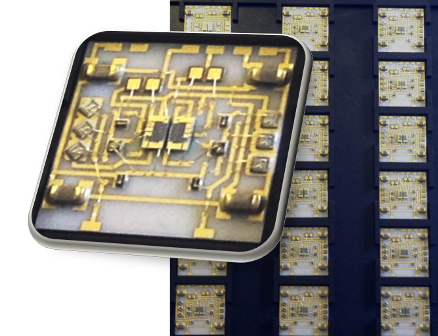

An engineer for a major aerospace contractor was working on a prototype for a new classified airborne sensor. The mechanicals were exceedingly tight and he needed a MMIC switch driver with specialized capabilities but found no off-the-shelf technology that would fit.

The open carrier switch driver built by Monzite for an airborne sensor system
The problem at hand was dealing with variable high output voltages from an array of MMICs. After reviewing specs of several hybrids made by the Impellimax division of Monzite, the engineer picked up the phone. He’d seen a subcomponent that could handle the voltages, but the device was too big. So he wanted to see if there were other options short of a costly, customized product.
“It was great to get on the phone and talk through the issue he was facing because as the discussion progressed, it sparked an idea,” said David Robbins, CEO at Monzite and an electrical engineer.
If space was not an issue, an interface logic chip slotted between the MMICs and the switch driver to manage the voltages would be the solution. Given the small, multi-layered design of the sensor, and the need to drive five MMICs, using conventional logic chips wouldn’t work.
“On the call we were throwing ideas around and doing a bit of design on the fly,” Robbins said. “And I think because we understood each other and started to develop a rapport, he agreed to give the new idea a shot.”
The idea was to “unpack” some of the miniaturized building block technology used in several Monzite/Impellimax hybrids and create a new type of chip-and-wire open carrier switch driver on a ceramic substrate that could handle higher voltages from all five MMICs in the prototype. Plus, Robbins theorized this new class of switch driver could connect directly to the sensor’s FPGA (field programmable gate array).
“If we could run this right from the FPGA, then we’d free up a lot of space on the board and also save some money by eliminating five logic chips,” Robbins theorized.
Beyond the very tight mechanical specs of the prototype, the new switch driver would have to meet military standards for reliability, be designed for automated pick-and-place manufacturing, and be optimized for size, weight and power (SWAP).
After the call, Robbins briefed Phil Casissta, the founder of Impellimax and chief engineer at Monzite, and the pair got to work. About two weeks later, they had the subcomponent ready to ship.
“It solved the engineer’s problem,” Robbins said. “And what’s really cool, is that by taking that extra step to engage in conversation about the problem, we’ve ended up with a new piece of technology that can eliminate the need for an interface chip in many other applications.”